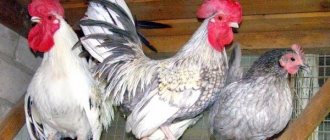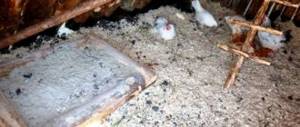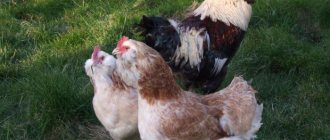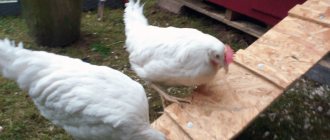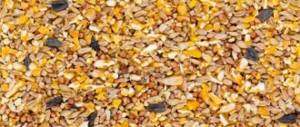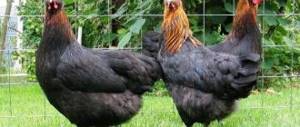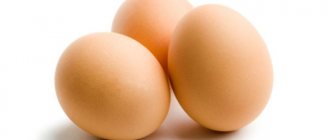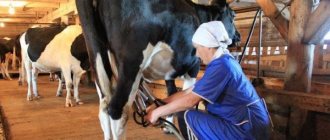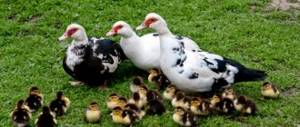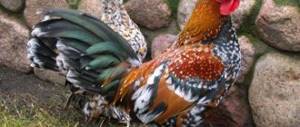Maintenance and care
Caring for Chinese royals is very easy, but it is important to take into account several nuances. Let's see the intricacies of the care and maintenance of these birds
- The main secret of the excellent taste of meat is an active lifestyle. Therefore, the herd should have a spacious range with a high fence over which it cannot fly.
- Chinese birds are not resistant to frost, and in winter they need additional heating. The minimum permissible temperature is 4-5 degrees.
- To prevent birds from getting sick, it is recommended to monitor the hygienic condition of the poultry house and promptly process and disinfect it.
- The advantage of these birds is their compactness. They do not occupy huge territories and do not need extended space. On vacation, they huddle together on perches and warm each other like penguins.
Molting and break in egg production
Seasonal molting is observed in all adult representatives of the breed, and proceeds quite quickly if they are well fed. During such periods, chickens need vitamins and easily digestible fats.
The break in egg production does not end at the end of molting, because during the winter, blackbacks practically do not lay eggs. Seasonal molting can begin in both autumn and winter.
Planned herd replacement
Each poultry farmer must make a decision on a planned replacement independently. It is worth considering that already at the age of 80 days, on an industrial scale, excess cockerels and chickens with deviations from the standard are sent for slaughter. At such a young age it is most delicious. In terms of egg production, laying hens last about 2 years.
Frequent illnesses
Compared to their ancestors, royals have stronger immunity. They rarely get sick, but their plumage often suffers from parasites and mites.
In this matter, it is most reliable to carry out effective prevention, because some types of parasites, such as, for example, lice eaters, can lead to irreversible consequences and inevitable death of livestock.
What are the reviews?
Conditions and care for bantams
Before you start breeding mini-chickens, you should find out what requirements they place on the poultry house and in what conditions they feel comfortable.
Bantams are heat-loving chickens. Poultry farmers living in the middle zone or northern regions of the country keep birds in insulated poultry houses. The indoor temperature should not drop to +14 degrees. During severe frosts, the chicken coop is heated . To preserve heat, it is recommended to lay a thick layer of sawdust on the floor.
To remove harmful fumes of ammonia and hydrogen sulfide, the barn is equipped with a ventilation system. With its help, it is easier to maintain a suitable humidity level - within 55–65%. Perches for chickens are installed at a distance of 40 cm from the floor. Lighting plays an important role for bantams. These birds are not already characterized by high egg productivity, and if the daylight hours are insufficient, this figure can be halved.
Bantams are active, so they need walking. During the warm season, they spend most of their time outside. Representatives of this breed fly well - this must be taken into account when arranging an aviary. The recommended height of the fence for mini-chickens is 2.5 m.
Attention! Bantams, who are given the opportunity to roam freely, lay eggs in secluded corners of the farmstead, where they are difficult to detect, and begin to hatch them. There is no need to panic - when the hen gets hungry, she will certainly come to the feeder.
Keeping bantams does not require much effort from poultry farmers. Caring for them is the same as for representatives of other breeds. The main thing is to keep the chicken coop clean, provide the birds with a sufficient number of feeders and drinkers, and give them the opportunity to spend more time in the fresh air.
Features of feeding miniature king hens
Bantams eat several times less than any other chickens, so it is convenient to feed them with ready-made feed. It contains everything that birds need for health:
- grains and legumes;
- cake;
- bran;
- vitamins;
- minerals.
Food is distributed three times a day. In the warm season, when it dawns early, the feeders are filled at dawn. In autumn and winter, birds have breakfast at 9 am. Food is brought at regular intervals, preventing the birds from becoming very hungry. Irregular feeding leads to digestive disorders and goiter diseases.
Attention! If the breeder does not use feed, mineral supplements must be added to the birds’ diet - chalk, bone meal, shells, crushed eggshells, and fish oil.
Breeds of colored broilers
Farmers strive to raise only the best varieties of broilers. And this is correct, because this choice allows you to get about 3 kg of meat in net weight by the time of slaughter in 2-2.5 months. The most interesting broiler breeds with colored feathers are listed below.
Sasso
The French Sasso breed of colored broilers are chickens with:
- small head;
- broad chest;
- strong bones;
- yellow paws and skin of the same shade under a layer of feathers;
- small comb and earrings;
- short wings;
- small light beak.
The plumage is variegated, with splashes of red.
Important! Chicks from Sasso chickens are born with white feathers. They have strong, thick legs and the ability, with a minimum amount of food, to increase their weight by 50-60 grams every day during the first months of life.
The Sasso chicken breed is raised primarily for meat. An adult chicken weighs about 4 kg at the time of slaughter, and a cockerel weighs 6-7 kg. But most often, chickens are slaughtered at 2 months, when they reach a weight of 2.5 kg. The only negative can be found only by those who raise chickens for eggs. Moreover, hens begin to lay eggs very late, at about 8-12 months, which does not allow them to recoup all the spent feed.
The description of the Sasso chicken breed is very similar to ordinary domestic laying hens. Its advantages include the ability to survive in difficult conditions, strong immunity, and good incubation of eggs. You can purchase eggs and chickens from Sasso chicken, the description of the qualities of which satisfies the needs of the farmer, at almost any poultry farm.
Redbrough
Broilers of this breed were obtained after crossing Malaysian chickens with Cornish chickens. English breeders got down to business. The result of many years of research was the production of redbro. In birds:
- well-developed muscles (a strong skeleton and legs were inherited from fighting chickens);
- red-brown with small patches of white feathers;
- tasty, slightly fibrous meat that meets all quality standards.
Redbro - red hens on a walk
Redbrown chickens are easy to care for. They gain weight even by grazing, eat everything the farmer gives, and are not picky. Laying hens weigh about 3 kg, and roosters up to 5 kg. It is difficult to guess that the farmer is looking at truly purebred birds; they can be raised in the same way as ordinary outbred birds; their behavior is appropriate.
Neighbors in the poultry house are hardly bullied, and the fighting character does not appear. They begin to lay eggs at six months, egg production is high, chickens are bred not only for meat, but also for eggs.
Master Gris
The chickens were bred in France. They are distinguished from other broilers by their increased speed of puberty. The hen begins to lay the first eggs at 4 months. Broilers master gris:
- white, gray-white individuals are rare;
- have a meat and egg orientation;
- unpretentious, almost 98% of the brood survives;
- They quickly gain weight, females weigh up to 4 kg, and males up to 7 kg.
The chicken meat is tender and smells nice.
Attention! It can also be grown to produce eggs - the quantity is not much inferior to what birds lay for eggs.
Foxy chick
Meat and egg chickens. From English the name of the breed can be translated as “fox chicken”. This is due to the orange colored feathers covering most of the carcass.
They came to Russia from Hungary and are the best broilers that can be raised in the country. Already at 1.5 months they weigh about 1.4 kg. Birds:
- in 1 year they lay about 200 eggs weighing 60-70 g each;
- large - an adult rooster weighs 6.5-7 kg at the time of slaughter, a chicken weighs 3.5-4 kg.
They are not picky about food; red broilers eat any food offered to them.
Red broilers on the farm
Naked neck
Broilers of this type tolerate summer heat and winter frosts well, do not need an additionally insulated chicken coop, the main thing is that they are fed and dry. Naked neck has:
- wide chest;
- straight back;
- motley plumage (neck bare);
- strong and long limbs;
- standing comb.
Both adults and chicks are non-conflicting. The meat is similar in taste to turkey. The weight of roosters is 3.5-4 kg, chickens are 3.5 kg. The breed is exclusively meat; no more than 150-160 eggs can be collected per year.
Important! At home, even if you have an incubator, it is almost impossible to raise birds of this breed. It is better to buy chickens at one day old
They are in particular demand on the farmsteads of European farmers; they have not yet gained popularity in Russia.
The most popular breeds of fighting cocks
Today, quite a few species of these birds are known, but some of them are the most ferocious and aggressive. Breeders keep fighting birds not only to earn good money. Those people who organize fights also earn decent money on bets. The most powerful fighting breeds of chickens are: Azil, Lari, Indian, Belgian, Shamo, Yamato. Let's look at each of them.
Azil
This is the oldest breed of fighting roosters and is very popular among farmers. This bird is native to India; in Europe such chickens are called Raja. They are distinguished by their strength and endurance, which allows them to carry out several battles in a row, and in most cases winning each one.
These chickens are distinguished by their strong build, medium height and short but powerful legs. Characteristic features of appearance include small pointed ears, a large beak, and color - red, brown or gray. Azil fighting cocks reach their peak at the age of 2 years. Food should contain a lot of proteins and vitamins.
Fighting chickens of this breed are excellent fighters, however, they show friendliness towards the owner, recognize him by his voice, and sense his mood. Birds of this species are created for fighting; without regular fights, it becomes lazy. In battle, the rooster is very smart and cunning, and often manages to deceive the enemy. The owner of Azil must have a strong character, fighting chickens must be kept in military conditions, and then they will show results.
These birds are distinguished by their unique fighting style. Breeders consider these fighting cocks to be among the most skilled opponents. There are few who are able to fight on equal terms with a representative of this species. If you follow all the rules of care and maintenance, you can regularly win tournaments and competitions.
These fighting chickens need to be constantly trained as they quickly lose their shape. The main feature of this breed is their widely spaced legs, which greatly help them in battle. Thanks to this, roosters can pounce on the enemy at lightning speed at any time. Appearance: small head, long neck, strong chest, different colors. They have a cocky character and prefer to show their strength in front of weak individuals.
When buying chickens, you need to look at their external characteristics, as defects are common: lethargic, barely standing on their feet. Males should not be kept together, they are very aggressive and, in this case, a fight cannot be avoided. In battle, Lari roosters are very graceful and strong, and it is extremely interesting to watch their movements.
Indian fighting breed
Indian roosters have the strongest limbs, which help them in battle against their feathered counterparts. This breed was created by crossing several other species. They do not tolerate cold and dampness well. They are easy to train, but they must be constant. Fighting roosters of the Indian breed are unusually strong, but not very hardy.
Thanks to their aggression and cockiness, they win most battles. However, if the enemy exhausts them, the Indian rooster will not be able to return to the fight. From childhood, it is necessary to feed fighting chickens with protein food so that they slowly get used to it. These birds are extremely conflict-prone; it is not recommended to keep them together with other relatives.
Belgian fighting
One of the most ancient breeds of chickens, bred in the 17th century in Flanders specifically to participate in battles. Externally, it is distinguished by a horizontal back posture, as well as a very large muscular body. The Belgian Fighting Cock is very persistent, although it does not have high speed and mobility.
A very difficult opponent for the Indian breed, because due to its endurance, the Belgian rooster will be able to exhaust the enemy and win the fight. Young individuals are practically not susceptible to disease, and are unpretentious in their housing conditions and choice of food.
Fighting roosters of this breed are considered one of the most popular in the world. In Japanese, "shamo" means "fighter". Representatives of this species can be divided into 3 groups: large, medium and dwarf. They differ from each other only in weight; their appearance is almost identical. Characteristic features of Shamo chickens:
- long wide head;
- muscular cheeks;
- elongated curved neck;
- The chest is muscular, protruding forward with bare bones.
Shamo is a rather tall and muscular rooster with the head of a predator. As fighters they have a high level of endurance. Despite the fact that adult birds are not afraid of dampness and are resistant to diseases and infections, they need special care. It is expressed in providing a spacious place for regular walking of roosters. It is necessary to feed with protein foods, and carefully monitor the crossing: mixing of blood should not be allowed.
Dwarf chicken breeds Top 5 best
Among the miniature representatives of the chicken world, there are popular and unpopular ones. Some are common throughout the planet, while others are exotic dwarf chicken breeds that are rare and quite expensive.
Below we will look at 5 representatives of this trend that poultry farmers love more than others.
Cochin dwarf chickens
Many farmers associate the name with the powerful Cochin Chough, which belongs to the meat category. But they also have small relatives who are bred for decorative purposes. A tiny copy of the Cochin appeared in China, and a very long time ago.
In those days when the first furry dwarfs appeared, only a few knew about them. This is not surprising, because the species was bred exclusively for the imperial court, and no one else had access to these little beauties.
Later, the emperor himself gave his wards as a gift to the ruler of Great Britain, and since then they began to gradually spread throughout Europe.
Let's move on to consider the characteristics of imperial chickens.
- The body is compact, squat, with a short back and elongated neck, V-shaped. Despite the fact that the runts are very small, they have a clearly defined chest and belly, which look larger than it due to the thick and lush feather cover. In order to complete the overall picture, let’s look at weight indicators. On average, a mature chicken reaches a body weight of 650-700 grams, and feathered men can weigh only 100-150 grams more.
- The feathers of mini-Cochins are thick, covering the entire body and even forming lush “panties” on the legs, which is why the beauties appear even shorter. There are different color options - in this, dwarfs are similar to their standard relatives.
- The head is small, with a well-developed crest and earrings. Large, expressive eyes, the color of which depends on the main color, also attract attention.
- Baby Kochs are calm and tame, leisurely, friendly and affectionate. They have a well-developed brooding instinct, and these hens can take care of their offspring.
- Raising such a flock is not easy - decorative chickens require a lot of attention to maintain their attractive appearance.
Shabo dwarf chickens
The history of this chicken is very long that modern scientists collect it bit by bit from all the sources available to them. Shabo is the result of the work of ancient Japanese bird breeders, who managed to breed one of the very first miniature birds in the world.
In the old days, keeping Shabots was very fashionable and all representatives of the eastern aristocracy kept them as pets.
In the 19th century, this unusual fashion migrated to Russia, and already here, dwarf breeds of Shabo chickens appeared in many courtyards of noble and wealthy people.
What is so interesting about the chickweed, which has won the hearts of aristocrats?
- The first thing you might think when looking at Shabot’s representatives is that they are disproportionate. The body type is atypical for chickens - an elongated, vertical body, with a very wide, prominent chest. The body also seems massive due to the very short legs.
- Feathers can be smooth or curly. There are black, gray, fawn, white with black borders. The tail and wings are long.
- It is impossible not to pay attention to the huge combs of cockerels; they are erect, with 4-6 teeth. The earrings are round in shape, also hang down on the chin by 2-3 cm, and are painted bright red.
- The excellent character makes the miniature Japanese even more attractive. You can watch the behavior of the birds for hours - they are not afraid of people, they boldly go into their hands and allow themselves to be stroked. In addition, hens cope well with their maternal tasks.
Dwarf chickens Malaysian Serama
Exotic Serama today is very small in number - this is due not only to the high cost of incubation material. The problem is also that it is very demanding on living conditions, does not tolerate transportation well and is not able to quickly adapt to a new climate.
Malaysian breeders worked on its creation, and to achieve their goals they used representatives of Japanese varieties and local chickens. Many modern scientists are still interested in Serama and are trying to improve it.
The main problem of blackfish is that in the second generation the color splits and different weight indicators may be observed.
- Purebred Seramas are the smallest of all chickens on the planet. They are slightly larger than a pigeon, and their adult body weight ranges from 250-350 grams.
- The body is also not entirely standard. The elongated body is located vertically, and the angle of the back is 90 degrees. The chest is round and wide, as is the back. The legs are very short, so the quons look squat.
- Feathers of different colors. The peculiarity of the plumage is that the tails of hens and cockerels resemble those of a peacock. The tail feathers are very rigid and together form a vertical “fan”. Due to its long wings, Serama can fly high, even 4-5 meters. For this reason, they are often kept in covered enclosures, since the curious birds are completely defenseless against the threats of the outside world.
- Serama, although difficult to grow, is very profitable - it consumes about 40-50 grams of feed per day.
Dwarf chickens Bantams
Typically, bantams refer to the general direction of tiny quons. There are different varieties of bantams. Calico bantams are very popular among beauty connoisseurs. They come from Japan and have a characteristic chintz color, which contains a pattern of three shades.
Lightweight dwarf breeds of Bantam chickens grow up to 0.5 kg, and their cavalier leaders weigh 0.8-0.9 kg. Another equally well-known species is the hairy bantam. In many ways, the birds have similar characteristics to representatives of Shabo, and the Land of the Rising Sun is also considered their homeland.
And of course, Altai - these short ones are distinguished by their fighting character and relatively high egg production. With minimal weight, laying hens manage to lay up to 140 eggs, 35-40 grams each.
Chickens
Chicks are covered with black-brown or black-and-white down, with stripes on the back. Initially, it is difficult to distinguish them by gender, but already at 3-4 weeks everything becomes clear, since girls fledge much faster. Already at 2 months they weigh over 700 grams.
Cubs come into this world with enormous potential for rapid growth and development, and based on this, the diet must be fully consistent with this feature
This means that you need to focus on the increased content of proteins, as well as vitamins and minerals necessary for growth, in order to avoid the appearance of developmental defects. The food does not differ from the standard, both from the first days and for older chicks
During the intensive growth stage, combined feeds with a high protein content, as well as vegetables and herbs, are suitable.
History of the origin of the Royal Chicken breed
From 1989 to 1990, hatching eggs of dwarf gudans were imported from Great Britain to China. The Chinese were interested in this bird for its high gastronomic qualities (taste comparable to game, low amount of internal fat), rapid growth and maturation. Among the disadvantages, they noted low weight (rooster - 1.1 kg, chicken - 0.9 kg), low egg production, weak immunity and survival of chicks.
The work with the bird was carried out by Professor Du Bingwang in Guangdong Province. On April 27, 2009, a report was submitted to the Department of Agriculture on the work done with the poultry.
Five groups of birds were studied over four generations. The bird's genetic stability has been confirmed.
During this period, the bird has already become widespread in 25 districts of China. The population increased to 8.3 million. It was decided to further breed the bird in purity and approve the name of the breed Royal chicken (royal chicken).
How to determine the age of a chicken
Sometimes private owners or inexperienced farmers fall for outright deception on the part of the seller. Wanting to buy a young laying hen, they go home with an adult chicken, whose reproductive age is nearing the end.
First of all, you should pay attention to:
- chicken belly. The older the individual, the harder it is due to accumulated fat;
- In an adult bird, blood circulation is impaired and the crest becomes light pink and cool. In a young laying hen it is warm and bright;
- The young bird's beak is yellow. In adults it is paler.
Be sure to feed the birds
Young and inexperienced chickens will quickly rush to the treat, while older ones will approach slowly and carefully
The unique composition of green eggs
The weight of exotic testicles is small - up to 50 grams. The composition is truly surprising. Here is a list of valuable substances they contain.
- Lecithin.
- Vitamin A and E.
- B vitamins.
- Iodine.
- Selenium.
- Zinc.
- Amino acids.
This is not the entire list of useful substances. Only those elements whose concentration is highest are presented.
Thanks to such a unique composition, scientists from the Second Shanghai Medical University began to show interest in them. After research, they confirmed the therapeutic and prophylactic qualities of this product.
After such statements by scientific luminaries, the product began to be actively used in traditional medicine directly in China and far beyond its borders. Today, an extract from them is used as a basis for dietary supplements and other drugs.
Among the diseases that poultry products can cure are the following.
- Anorexia.
- Stunted growth.
- Hormonal problems.
- Thyroid diseases.
- Immunodeficiency syndrome.
- Diseases of the cardiovascular system.
- Gynecological disorders.
- Digestive problems.
Advantages and disadvantages
The partridge variety of brahma is common in Russia and is in demand. It is valued for its attractive appearance and good meat qualities. Some poultry farmers breed these chickens to sell hatching eggs and chicks, while others breed them for poultry products. The advantages of the line also include its phlegmatic character and good adaptive qualities. It is not difficult to handle the bird; it is undemanding in terms of food supply and living conditions.
Minuses:
- due to their large size, birds need a spacious barn with a walk;
- late onset of puberty;
- low survival rate of young animals - 87%.
Advantages and disadvantages of the breed
Coral chickens have the following advantages:
- flexible character;
- the need for a small amount of feed;
- excellent egg production;
- resistance to diseases.
Coral chickens are characterized by high egg production and unpretentiousness.
The disadvantages included their foreign origin, which affected the cost of chickens. However, today coral breeding is already carried out on the territory of the Russian Federation.
Breed overview
Chinese silkies stand apart among all breeds of chickens. They have too much melanin in their bodies, which turns their skin, bones and meat black. But feathers do not contain this substance, so the color of the plumage can be red, gray, motley and even boiling white. Their plumage is also unique: it is silky to the touch and looks like the wool of goats or sheep.
Chinese silky chickens
Such chickens are usually bred as an ornamental breed, and the Chinese consider their meat to be the greatest delicacy.
Breed of chickens Ayam Tsemani
The name of this breed means “black rooster” and fully corresponds to the appearance of these individuals. The homeland of chickens is the island of Sumatra. What makes these birds special?
Ayam-Tsemani chicken and rooster
They are completely black - from the comb to the limbs. Similar coloring is found in some other breeds. The unusualness of this particular species is that its meat, bones, entrails and even blood are black.
| Productivity characteristics | Description |
| Adult chicken weight | 1.4–1.5 kg |
| Adult rooster weight | 1.9–2.0 kg |
| Egg shell color | light cream |
| Egg weight | 48–50 g |
| Egg production | 90–100 pieces per year |
Laying hens do not have high egg production, but the size of their eggs is proportional to their body weight. The eggs are oval in shape and the shell is durable. The taste of eggs laid by individuals of this breed does not differ from eggs laid by ordinary chickens.
Typically, an incubator is used to hatch chickens of this breed. The size of newborn Ayamtsemani babies does not differ from the size of chickens of other species. Their fluff has a characteristic black tint. The diet of these babies consists of dry feed (corn grits) or ready-made industrial feed for chickens (according to their age).
Currently, there is no single standard for individuals of this breed. The main thing is the completely black coloring of roosters and hens from the comb to the toes. Only those individuals that have white spots on their toes or even on the end of their tongue are culled.
Ukheyilyu is another breed with black meat
It is not easy for a Russian person to pronounce the “name” of these birds. And no wonder - after all, these chickens live mainly only in China, and their name is appropriate. The date of origin of the breed is unknown, most likely its age is calculated in centuries.
Over time, they began to forget about this breed, and it was literally on the verge of complete extinction. Until, at the end of the last century, several of its last representatives were found in one of the Chinese villages. There were only two hens and one rooster.
Cockerel and hens of the Ukheyiliu breed
Scientists conducted a series of genetic examinations and confirmed that these are indeed representatives of the Ukheyilyu. And although there were very few birds to preserve and breed the breed, it was still possible to preserve it and significantly increase the population.
External signs of the breed.
The skin, plumage and the whole body, as they say, from head to toe, are perfectly black. These Chinese girls cannot boast of large sizes - the weight of males does not exceed 2 kg, and that of laying hens - 1.3–1.5 kg.
The body of these individuals is medium in size, the plumage is dense, under which a downy “lining” is hidden. It has a greenish tint, and the comb, earrings and earlobes have a purple tint. Legs are medium size, grayish in color.
The head is small, the eyes are blue-black. The leaf-shaped comb is small and has 6 teeth.
Ukheiliyu are very peaceful and calm chickens. They get along well with each other and other individuals in the house. They are extremely active, so they should be allowed out into the enclosure for walks every day.
We invite you to join our group on VKontakte or Odnoklassniki, where new articles are published, as well as news for gardeners and livestock farmers.
Productivity of the Royal chicken breed
As a result of the work, poultry productivity increased: poultry weight (rooster - 1.6 kg, chicken - 1.25 kg), egg production - 180 eggs weighing 38-43 g.
Egg fertilization rate 84%, survival rate 96%. The rate of growth and maturation of the bird is preserved. Chickens begin laying eggs at 150 days.
The average weight of a carcass at the age of 80 days is a rooster -0.9-1.1 kg, a chicken -0.8 kg. Feed consumption for adult birds is from 50 to 65 g per day. To obtain a carcass weighing 1.0 kg, you need 4-5 kg of dry feed, which is intended for broilers.
Currently, Royal chicken in China is bred on an industrial scale and has high economic value.
Breed overview
Chinese silk chickens are little known to novice poultry farmers. This is due, first of all, to a certain unusualness and rarity of the species. However, they perform not only the function of decorating the yard, but also have an agricultural purpose. This breed is valuable due to its high taste qualities. Its meat is considered a delicacy; moreover, it contains a large amount of vitamins and amino acids that are beneficial to the human body.
Silk chickens are distinguished by their small body size, but laying hens are capable of hatching eggs weighing up to 35 g. As for their quantity, you can get about 120 pieces per year from one individual. The hen instinct of these birds is well developed, so they hatch not only their chicks, but also foundlings with special tenderness and care.
Chinese chickens have a peaceful nature. Due to this, they get along well with other birds, and also enjoy spending time in the company of people, allowing themselves to be stroked. Thus, silky chickens can be sheared without much difficulty, and their fluff is used for its intended purpose.
To distinguish this breed from another, you don’t have to see it in real life or on video, just read the description. The main distinctive characteristics of silken chicken include the following:
- most feathers of representatives of the silk breed do not have hooks;
- the plumage itself looks more like fluff or wool;
- correct structure only on tail feathers and some flight feathers;
- feet have five toes;
- They have an unusual dark blue skin color, closer to black.
Origin story
As is already clear from the name of the breed itself, silk chickens come from China. The first mentions of them are found in the notes of the traveler Marco Polo, who spoke about birds with black hair instead of feathers. There is an assumption that black silk chickens are the result of crossing chickens with rabbits. Although this, as you understand, is one of the myths about this bird.
The breed was officially recognized in America in 1874. Its development was facilitated by the desire of wealthy aristocrats to have birds with crests and original plumage in their gardens, which more closely resembled silk. At that time, this breed of chicken was called “silki”.
Today, unusual “fluffy” chickens are bred all over the world. As for our country, the Chinese silk chicken was first mentioned in Russian chronicles in the 18th century. Despite climatic differences, this species has acclimatized well in domestic conditions. At the moment, black or Chinese chicken is found in various poultry farms.
Appearance
It is enough to read the description of the appearance of this breed and it immediately becomes clear that it is impossible to mistake it for another. Silk hens with their cap look like a poodle, and roosters have a beard and sideburns. The plumage is delicate and shiny in appearance, and is very reminiscent of silk. There are no hooks on the feathers, which is why they are so elegant and perfectly smooth.
The “black” chicken has a round body shape. Her back is wide and short, and her shoulders protrude. The lower leg is completely covered with feathers and is quite short. The tail feathers are clearly visible in the tail. Silky Chinese chickens have black eyes, turquoise lobes, a comb and a blue beak. The plumage of this breed can have a variety of colors: white, gray, golden, black and even blue.
In their homeland, these birds are called chickens with crow bones, due to the fact that their bones, skin and muscles are black. This color is due to the diffusion of the natural pigment eumelanin in the tissues of chickens. The silky breed has soft and silky plumage, the presence of five toes, as well as black skin and bones. The internal organs are also black. After watching the video (author Tatyana Kholomyova), you will understand why these chickens are so special.
Main varieties
Three groups
The bantam breed includes dozens of subspecies. For ease of classification, they are divided into three groups: true, dwarf and developed.
True lines are called lines of chickens that have no analogues among large breeds, but have mutated due to natural reasons.
Dwarf - a line of birds artificially bred in eastern countries that are more compact in size, but retain the main features of large breeds of chickens.
Developed – artificially bred lines of American or European breeding.
Consider the popular varieties of bantams
Korolek
One of the smallest representatives of the breed, known in Russia since the 17th century.
According to legend, chickens were named this way because they have a truly “royal” character, but they did not grow up to become full-fledged royal persons. In a word - “kings”, not kings.
It is interesting that for the third century, debates have not subsided among scientists whether the kings belong to bantams or are another breed of chickens.
Nanjing
The oldest representatives of dwarf chickens.
Distinctive features are the yellowish-orange color of the crest with a speckled pattern and a voluminous “bib” in black tones.
Featherfoot
They are considered one of the most beautiful birds in the world.
Chickens are distinguished by a neat leaf-shaped comb on the head, rich variegated plumage on the body and light feathers on the legs.
Beijing
Chickens, which were named so because they are an exact copy of the Peking breed, “made” in miniature.
A distinctive feature of Beijing mini-chickens is their large, heavily furred limbs.
Dutch
Otherwise known as “fairytale” chickens, because they look like birds from fairy tales.
“Dressed” in black plumage and decorated with a light V-shaped crest, unusual for chickens.
A full description of this breed is given in the article “Characteristics of Dutch white-crested chickens.”
Paduan
The most valuable representatives of bantams.
Chickens are distinguished by the presence of a funny beard, a fine comb and a long feather of a rich golden hue.
Seabright
Chickens are distinguished by a short back, well-developed chest, lush feathers with decorative black edging and a crest shaped like a rose.
Farmers are not particularly willing to breed these birds due to their poor health and low survival rate of young animals. Now they are actually on the verge of extinction.
Read more in the article “Seabright chickens”.
Hamburg
Otherwise known as black and white bantams.
The chickens' calling card is a bright red comb and lush black and white plumage, shimmering in the sun with various shades of blue and purple, just like their famous standard counterparts, which are described in the article “About Hamburg chickens.”
Shabo
A Japanese species of bantam of dwarf stature, representatives of which have unusual long wings and completely hairless paws.
Read more in the article “Description of the Shabo chicken breed.”
Barnaul
The chickens come from Barnaul.
They are distinguished by rich plumage that forms an unusual “hat” on the head, a wide variety of colors and a strong, well-built body, which is unusual for the decorative trends of chickens.
Calico
The calico or Japanese bantam is a chicken that resembles a walnut bantam in appearance, but with a more variegated, “calico” feather in texture.
Her homeland is the Japanese Islands. However, such bantams are also found in other parts of the planet, including Russia.
Nut
Bantams of this type are popular in Russia.
Their main differences are a light chocolate feather covering with a gray tint, a medium-sized nut-colored head, luxurious wings that fit loosely to the body and completely bare legs with a blue tint.
Fighting
Strong and hardy bantams.
They have variegated feathers with a multi-colored tint, a fan-shaped tail and large wings.
Old English
According to one version, it is an exact copy of the ancient English fighting chickens in miniature.
The birds come in a wide variety of colors and weigh no more than one and a half kilograms.
Danish
Common in Denmark are hybrids of English fighting cocks and local meat-and-egg chickens.
They are distinguished by a squat body and a luxurious, high-raised tail.
Yokahama
Otherwise known as Japanese dwarf phoenixes. They can only be bred in the Land of the Rising Sun. One of the ancient bantams, which served as pets of Japanese nobles and even as “napkins” on which they wiped their hands after meals.
Chickens are distinguished by bright red-brown feathers that shimmer like melted gold in the sun, spurs on their legs and incredible tails, the length of which can reach several meters.
Malaysian Serama
A chicken bred by crossing wild Japanese and Malaysian birds.
It is distinguished by an unusual, almost vertical posture of the body, downward-pointing wings, a strongly protruding crop and an unnaturally curved, “swan” neck.
Features of keeping in the household
Brahma chickens will not cause much trouble to the farmer. The main thing is to build for them a spacious poultry house, equipped with strong perches, and a walking yard. Poultry care includes regular cleaning of the barn, providing birds with a nutritious diet and disease prevention.
How to set up a chicken coop for partridge brama: tips
For Brahma chickens, floor housing on thick bedding is suitable. The first thing to consider before moving into a poultry house is the density of the birds. Given the large size of the birds, each individual should have at least 0.7 m2 of free space. Representatives of the American line do not know how to fly high, so the perches are installed at a distance of 60 cm from the floor and equipped with ladders. Each adult is allocated 30–35 cm of pole length.
Gate chickens are suitable for floor keeping
It is very important to ensure good air exchange in the chicken coop. When droppings decompose, harmful ammonia vapors are released from the litter, which must be removed from the room
Otherwise, the chickens will get sick. A window will not solve the problem - in the winter the windows are covered with plastic film to protect the birds from drafts. You will have to install supply and exhaust ventilation in the barn.
A permanent bedding 20 cm thick is laid on the floor. It can be made from several components - sawdust, peat, straw chaff. Material with this composition perfectly absorbs moisture and eliminates unpleasant odors.
It is important to keep the flooring clean. The litter is regularly turned over to prevent mold from forming inside.
Every month the top layer is removed and a portion of fresh sawdust is added, after which the material is shoveled.
General cleaning is carried out 2 times a year. The farmer’s task is to remove the old litter and burn it, clean the floor and walls of dirt and remaining droppings, and treat the surfaces with lime. Equipment is also disinfected. A sulfur bomb is used to destroy mold fungi and ectoparasite larvae. It is set on fire inside the barn in the absence of chickens.
Brahmas lay eggs rarely, about once every 3-4 days, so they will not need many nests. 1-2 boxes per 10 laying hens is enough. They are placed on the floor or on a small elevation in the darkest part of the chicken coop. Soft straw is placed at the bottom. When it becomes dirty, it is replaced with a clean one.
Inventory
When the arrangement of the barn is completed, you need to buy equipment - a feeder for dry and wet food, a drinking bowl, a container for gravel and a trough for the ash-sand mixture. All this can be done with your own hands.
Containers for grain and wet mash are placed on the floor so that all residents of the poultry house can come up and get their fill. There should be about 25 cm of feed tape per hen. Failure to comply with this requirement will lead to conflicts between birds.
An ash bath is a necessary attribute of a chicken coop. Chickens love to wallow in dust, thereby cleaning their feathers of parasite larvae. Given the size of the bird, you will need a spacious basin or other container that can be made from boards.
Walk
Brahma chickens need a free run. Walking helps reduce stress, strengthen the immune system and prevent obesity. The aviary is usually attached to the southern wall of the chicken coop to protect the birds from the north wind. Its area is calculated based on the number of heads. For 10 chickens, 20–25 m2 of free space is allocated.
Partridge bramas on a walk in winter
A high fence will not be needed - heavy gates will not be able to fly over a one and a half meter fence. It is advisable to sow the area with grass so that the birds have something to do. During the walk, the birds eat fresh greens of nettles, dandelions, alfalfa, and look for worms, slugs and insects. It is a healthy addition to their diet.
Representatives of the Brahma breed can be allowed outside even in winter. However, in frosty weather you will have to limit yourself to short walks - 1–1.5 hours. On windy and rainy days, it is better for birds to stay in the comfort of their barn. In summer, laying hens are released outside early in the morning, after feeding, and driven home at dusk.
Nutrition
In matters of nutrition, partridge brahms are not picky - they eat the same as representatives of other meat breeds:
- different types of grain - millet, rye, millet, barley, corn, buckwheat;
- root vegetables and vegetables - potatoes, carrots, fodder beets, cucumbers, zucchini, pumpkin;
- greens - onions, nettles, dandelions and other weeds, tops from the garden;
- fermented milk products - whey, low-fat cottage cheese;
- meat and fish waste.
Feed for birds is enriched with mineral components - chalk, a small amount of salt, bone meal, fish meal and grass meal.
Nutrition
Important feeding nuances will be described below.
- It is advisable that the diet remains unchanged. Adjustments to the menu are made twice: in adolescence and during the laying process. Other changes are made as necessary.
- Cross corals do not need additional nutrition during the winter season. This species can lay eggs in both cold and warm weather. The hybrid is not afraid even of severe frosts.
- At 4 months, when hens are ready to lay eggs, a fattening menu should be added. The main emphasis should be on calcium. During this period, the bird needs this element more than ever, so the calcium content in food should be at least 2.5%. You can add proteins or proteins.
The amount of feed required directly depends on the conditions of detention. If the chickens are kept in cages, they won't need much food. If you keep them in pens, it means they lead an active lifestyle, therefore their body requires more food
Please note that if the diet is not followed, chickens will quickly gain weight. Excessive obesity in poultry will negatively affect egg production
The main feeding method is the dry method, which is actively used in all poultry farms. Thanks to this method, chickens will not lose weight, and feed consumption will be significantly reduced. The main product of the diet is a mixture of grains. You can also add raw vegetables, some fish, meat, and cottage cheese. Feeding is done early in the morning, at lunchtime and in the evening. Feed limit for 1 adult chicken is 100 g per day. If you decide to add third-party products to the feed, then you should make a calculation: the minimum daily requirement is 350 kcal if the birds are in an aviary.
If you raise chickens in a cage, then the minimum norm is reduced to 280 kcal. Oats are a source of fat and fiber. Sprouted oats prevent feather loss. In the cold season, it is recommended to feed barley. It contains a huge amount of carbohydrates. Corn is considered the most favorite delicacy of any breed of chicken. It is advisable to chop it before adding it and serve it only in small quantities so that the bird does not gain excess weight.
Features of breeding royal chickens
Being a fairly successful breed, king chickens are easy to breed, with an egg fertilization rate of over 84% and a 95% chick survival rate. At home, eggs can be hatched using an incubator or a hen.
Conditions for breeding are not much different from other breeds. Genetic material can be purchased from experienced breeders who will tell you how best to implement this and what needs to be done when the chicks are born.
Onset of puberty
Royals are fast-growing birds, so they reach sexual maturity at 5 months, after which they begin to lay eggs. The first production is quite small, the weight of one egg is 35 grams, but over time it increases to 45–48 grams.
In a year, one hen lays up to 180 eggs, more than half of which are fertilized and ready to hatch. Cockerels are active, courteous and caring towards females.
Maternal instinct
All representatives have high responsibility towards their offspring, so hens are not only excellent layers, but also hens. They carefully approach this process, prepare the nest and hatch the chicks, and during hatching they look after each chick. The hens teach the kids how to find food, walk together, protecting the brood from attacks by cats, and are wary even of the owner.
In industrial formats, birds are deprived of this process, and all chickens are hatched under incubation conditions. They are born on time, with strong immunity and quickly gain weight, reaching their maximum at the age of 10 months.
Planned replacement of livestock
Closer to 6–8 months, the male population can be slaughtered; they are sent for meat, leaving one, the strongest male, to fertilize the flock. When to hatch chickens, only the poultry farmer decides; each individual lays eggs until the age of two, but by this time they become smaller, and the meat becomes tougher and more sinewy.
As it turned out, royal chickens are not such royal people, they do not need specific conditions for keeping, they are not picky about food, although for the most delicious meat they need daily walking in the fresh air. Fertilization and survival rate are at a high level, so to breed the breed you will need desire, a small room equipped with everything necessary, a paddock for walking and high-quality food. It is better to purchase eggs for the incubator from familiar breeders with a good reputation.
Breeding Features
Bantams have excellent reproductive qualities and are famous for their maternal instinct. Chickens can continuously sit on eggs for several months and carefully take care of their own and other people's chicks, left unattended by hens.
This makes it easy to increase the number of chickens without incubation or other human intervention.
Bantam chicks hatch 2-3 days earlier than other chicken breeds. The survival rate of young animals is 85-95%.
